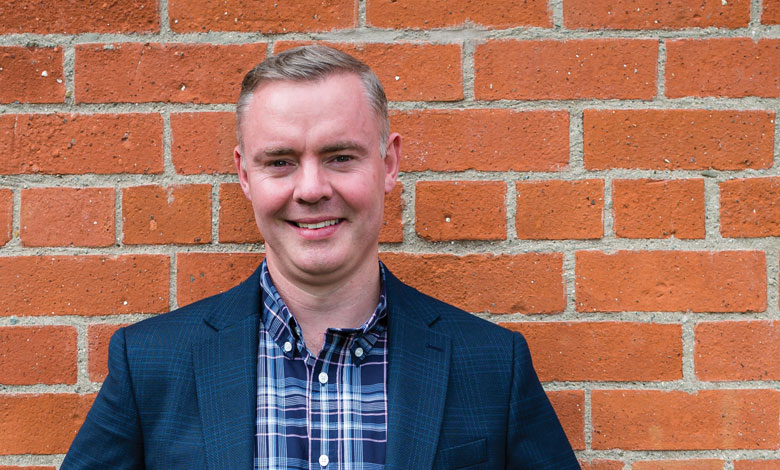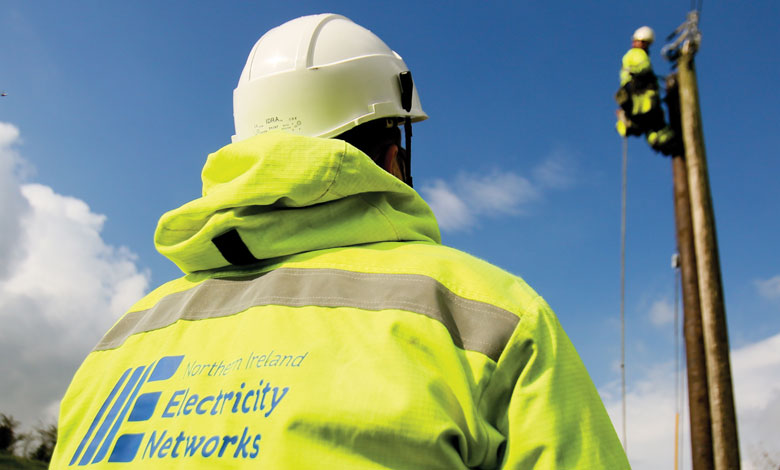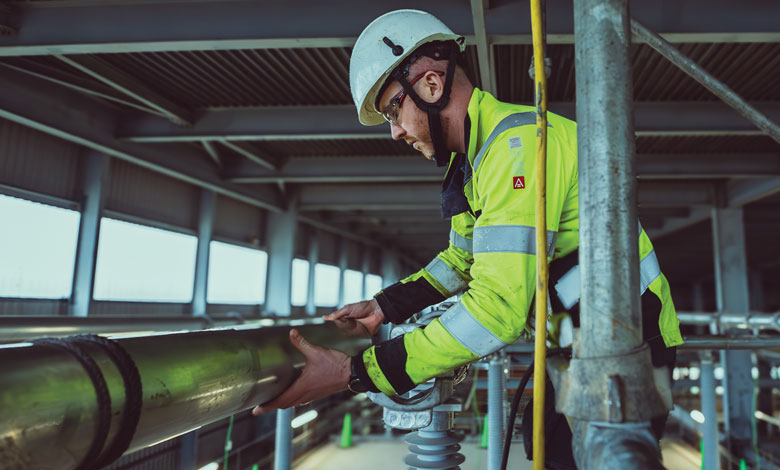
Economy Minister: Progressing the energy transition
27th May 2025
Filling the energy supply gap
27th May 2025Working in collaboration to unlock the potential of the network

Ronan McKeown, Director of Future Networks with NIE Networks, is a man who likes a challenge. Faced with the biggest transformation of the electricity networks in a generation, an increasingly complex energy system, and growing pressure for the network to do more, faster, he is also keen to exploit as many innovative and new techniques as possible.
Embarking on RP7
The company has just started its new price control period (RP7) which involves an unprecedented investment of £2.3 billion in the network over the next six years. The RP7 period runs up until 2031 and is a step increase in pace and scale in terms of transformation of the electricity network in order to facilitate a net zero carbon future. Their plan is to deliver an innovative, dynamic, and integrated electricity system that is designed to meet the future energy needs of Northern Ireland. This investment is in response to the rising number of low carbon technologies (LCTs) that need to connect to the network to help Northern Ireland meet its energy strategy ambitions.
The increased scale of funding, infrastructure upgrades, technology, and stakeholder interaction all require an evolution of the business model to maintain their existing focus on safety and efficiency, while investing in people and the technological capability to meet their RP7 commitments.
Bottom line, the company recognises that the way they have connected homes and businesses to the electricity network up to now will not work in the future.
Economic growth
The implications of the decisions they take are not lost on McKeown or his team. He explains: “The electricity network plays a crucial role beyond its core function of delivering a safe and reliable energy supply. Its capability and performance are closely aligned to economic growth and social development so we are conscious that the decisions we make today will have lasting implications not just for Northern Ireland plc but for all of us who rely on a reliable electricity supply.
“What is clear is that those countries worldwide who have closely aligned their net zero approach to economic delivery are the ones who are meeting or exceeding their climate change targets. For me that encapsulates the crucial role we play and how important it is that we are working closely with statutory bodies and industry.”
Electrification
NIE Networks generates revenue through a regulated model where every kWh of electricity consumed has a price associated with it. The revenues earned by NIE Networks are fixed by the Utility Regulator which means that the more electricity that flows through the network, the cheaper each kWh is for the homes and businesses here. Part of the solution for Northern Ireland plc therefore is to continue to electrify heat and transport but also to seek inward investment which can drive electricity demand to a level where electrification becomes more accessible to all. By targeting and supporting high energy users to invest and expand here, there are wider benefits for businesses and society which in turn will also help Northern Ireland to achieve net zero targets.
“Understanding how we collectively create that demand for clean and renewable electricity can benefit our lives and our economy. Electrification and economic growth are a circular system; growing the economy will increase demand which will place downward pressure on energy costs thereby driving expansion and economic growth,” McKeown explains.
The decarbonisation challenge is significant, but McKeown is confident that the solutions are to be found in the electricity network which he says can address many of the issues being faced including ESG targets, high energy costs, social affordability, and economic growth.
“The network and the workforce are there to deliver the opportunities available to us and make it work for the homes, farms, and businesses in Northern Ireland. As a company we are very conscious about the need to make the network work for the people of Northern Ireland and to do the right thing.”
Complex system
The electricity network in Northern Ireland has already been developing significantly to a point where nearly half of all electricity consumed here comes from renewable sources. Increasing the amount of energy that comes from renewables is influenced by a number of factors including markets, economic policy, and affordability.
McKeown explains: “The electricity system is a complex and sophisticated one and we are all the time working to push the boundaries and do more. We also have 929,000 homes, farms, and businesses who are relying on us every hour of every day to provide a safe, secure, and reliable supply. So, we need to push the network to do more within these confines, particularly as more people start to use the network to charge their car and heat their homes.”
“Our RP7 plan was developed with stakeholders to ensure we have the capability to meet the rising needs on the electricity network. This is challenging as the adoption of low carbon technologies such as EVs and heat pumps has not risen as quickly here as it has in other parts of the world. It is needed, however, if we want to reach our net zero ambitions so we are hopeful that through close collaboration with key stakeholders we can help stimulate the demand necessary to keep on track with the strategic energy targets.”
The company believes that the solution again lies in engaging with all parts of the energy ecosystem to ensure the infrastructure in Northern Ireland is developed holistically. “It is something we are working with statutory agencies to explore as we believe closer co-operation will allow us all to identify and exploit infrastructure opportunities that exist right now,” McKeown explains.
Business pressure
To meet Climate Change Act targets and ESG credentials, which are increasingly important to investors, businesses are working to decarbonise their operations. In a volatile trading market they also need to remain highly competitive and reduce their energy costs. It can become something of a conundrum as companies try to work out how to electrify operations yet remain competitive.
“I have had conversations with businesses where their plans to decarbonise had increased their capacity requirements and the connection charge they anticipated was out of reach for them financially. A relatively quick exploration of their operations allowed us to see that their capacity requirements did not need to be as high. As a result of that, and a few other creative solutions, the cost was reduced to a level that they were comfortable with. With the right information and insight we can make the electrification process simpler and much more efficient for businesses but the challenge for us is how we do that at scale,” McKeown says.
He continues: “Ideally we would want to be able to provide expert insight and advice to all businesses on a case-by- case basis, but in a world where every business is suddenly looking to decarbonise, that provides us with significant challenges. We are working at the minute to explore solutions whereby we scope the main challenges businesses are having and work to provide as much information as possible in a way that works for businesses.”
Current opportunities and collaboration
McKeown is clear that much can be done now: “There is, undoubtedly, opportunity for businesses within the network currently but it requires us to work much closer with industry to make those opportunities clear, to listen to their specific needs and to explore creative solutions. The key is collaboration with industry and making more information available to businesses so they can make more informed choices.”
Another local example indicates just how beneficial this closer collaboration can be for everyone. He talks of a company planning to electrify their fleet and needing a level of additional capacity which would have incurred network design, significant cost, and traffic disruption to lay new cables. By working creatively, a solution was found whereby the capacity is drawn down during the early hours of the morning when it is readily available. It prevented the need for any development works and saved money and disruption.
The imperative is to work strategically. “Strategic spatial planning should be a priority,” McKeown says.
“The road to net zero is a complex and multi-faceted one and no industry or company can provide the entire solution. An area we would be keen to see developed is strategic spatial planning which is effectively creating a map of investment ‘hot spots’ where sites which have water, electricity, telecoms, and other key infrastructure capacity are overlaid on a map and used by statutory bodies to plan and support businesses to invest, expand, and develop, or where infrastructure is developed in a coordinated manner to meet evolving long-term energy needs.”
His overriding message is that industry should engage and share information at an early stage.
“Right now, we are working with a large-scale energy user who is under significant time pressure to decarbonise their operations. The change will require more than double their current capacity requirements which involves significant work on our side. However, because we have been engaged at an early stage we can begin to plan for that so that when they come to the point at which they are ready to progress, we will be able to respond in a timely manner. I would strongly encourage any large-scale electricity users to engage us at the earliest opportunity if they have plans to decarbonise so that we can facilitate their requirements in a way that works for all sides.”
Connection process
Another key area of development is in relation to the connection process. A Department for Economy consultation on a new socialised connection model closed in April 2025. McKeown says, when implemented, it will create greater access to the electricity network and make it easier to decarbonise through electrification.
The proposal seeks to address one of the main differences between Northern Ireland and Great Britain in terms of electricity connections. In Northern Ireland, the first property or business to require a connection or capacity of a certain scale to that location will pay the cost for any reinforcements works required. In Great Britain they have a socialised charging model so the cost is paid for by everyone. This means that increasing the capacity to an area for a heat pump or an EV charger becomes a more accessible choice to domestic customers and for small businesses who are seeking to decarbonise their businesses and remain competitive.
The company are also looking at their own internal processes for connections. “Making the connection process easier and more transparent is a strategic focus for us,” McKeown says. “Businesses need to know upfront what opportunities are available, how they can make an application and that the connection process is smooth and swift.”
Contingency planning
With the increase in electrification comes increasing pressure to provide a reliable supply – and climate change is also making that more challenging.
McKeown agrees: “We have definitely seen an increase in the strength of the storms we have faced lately, particularly with Storm Éowyn which was hurricane level. Around a third of the properties in Northern Ireland lost power during the height of the winds. This was the worst network damage and social impact that we have ever seen. We were able to restore power to 75 per cent of properties within 48 hours of being on the ground, but for some, they were without power for up to ten days.”
In April 2025, the Iberian Peninsula was plunged into darkness when a sudden and widespread power cut caused all of Spain, and some of Portugal, to lose power.
“I think these events have probably prompted organisations to consider their contingency plans in the event of a power cut. How we use electricity has changed in the last five years and is likely to change just as much again in the next five. Companies need to be thinking about their plans in the event that power cuts are longer lasting or more widespread than we have been used to in the past. With all of these things you plan for the worst but hope for the best and that’s certainly something we are focusing on as well moving forward,” McKeown explains.
Much of the future remains unclear or undecided. However, what is clear is the level of challenge faced by industry and the network operators as they work across so many fronts in a rapidly changing world. McKeown remains optimistic that the opportunities are there to make positive differences on all fronts: “One benefit of being a small country is that closer collaboration is easier and I think we have resources available to us that we can exploit. We just need to work together and think creatively and I have no doubt we’ll be able to find the solutions in time.”



